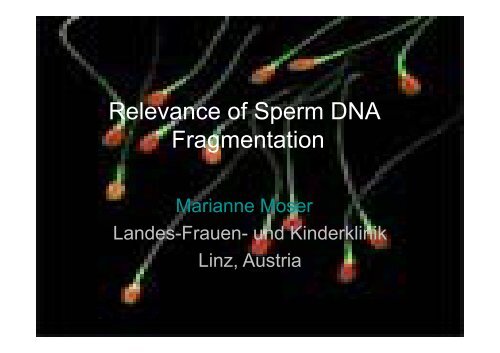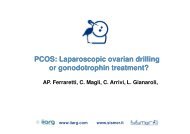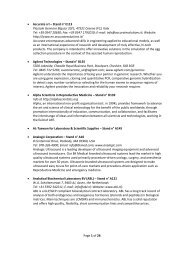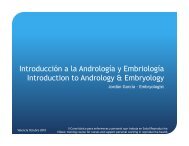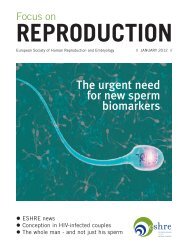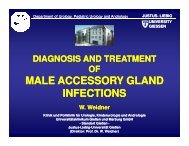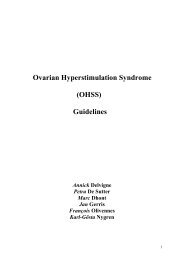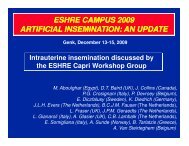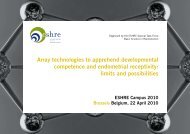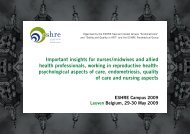Relevance of Sperm DNA Fragmentation - eshre
Relevance of Sperm DNA Fragmentation - eshre
Relevance of Sperm DNA Fragmentation - eshre
You also want an ePaper? Increase the reach of your titles
YUMPU automatically turns print PDFs into web optimized ePapers that Google loves.
<strong>Relevance</strong> <strong>of</strong> <strong>Sperm</strong> <strong>DNA</strong><strong>Fragmentation</strong>Marianne MoserLandes-Frauen- und KinderklinikLinz, Austria
<strong>Relevance</strong> <strong>of</strong> <strong>Sperm</strong> <strong>DNA</strong><strong>Fragmentation</strong>1. <strong>Sperm</strong> <strong>DNA</strong> peculiarity2. Etiology <strong>of</strong> <strong>DNA</strong> fragmentation (DF)3. Test methods4. Influence <strong>of</strong> laboratory techniques5. DF and outcome in infertility treatments6. Conclusions
1. <strong>Sperm</strong> <strong>DNA</strong> peculiarityDuring spermiogenesisspermatids repackagetheir <strong>DNA</strong> withprotamines, a smallresidue <strong>of</strong> histone-bound<strong>DNA</strong> is retained (15%).
protamines• Are proteins with a high content <strong>of</strong> positively chargedamino acids (48% arginine)• Form a highly condensed complex with the sperm <strong>DNA</strong>(<strong>DNA</strong> has a strong negative charge)• Incorporate cysteins• Cysteins allow the formation <strong>of</strong> disulphide bondsbetween the protamines• Therefore strongly stabilize the nucleoprotaminecomplex
In mature sperm the <strong>DNA</strong> is• 85% protamine bound• 15 % remains histone boundprotamine deficiency: more susceptible for ROSInfertile men have a higher histone:protamine ratio than fertile men(Oliva 2006, Zhang 2006)5-10% <strong>of</strong> infertile men have a complete protamine deficiency
Fig. 1: The human spermZini, A. et al. CMAJ 2006;175:495-500Copyright ©2006 Canadian Medical Association or its licensors
2. Etiology <strong>of</strong> <strong>DNA</strong> Damagethe etiology <strong>of</strong> sperm <strong>DNA</strong> damage ismultifactorial• In the testis during the process <strong>of</strong>spermatogenesis:– Apoptosis: screening mechanisms,that mark individual apoptoticsperms which causes phagocytosis<strong>of</strong> these cells, failed (double sb)– during remodeling <strong>of</strong> spermchromatin the <strong>DNA</strong> is unwoundthrough the induction <strong>of</strong> strandbreaks (single sb), sperms withunrepaired strand breaks →semen.
Etiology <strong>of</strong> <strong>Sperm</strong> <strong>DNA</strong> Damage• post-testicular:– during sperm transport through theseminiferous tubules and the epididymis– Varicocele– Genital tract infections (leukocytes)– Immature sperms (cytoplasmic droplet)– radio- and/or chemotherapy– Lifestyle factors (obesity, cell phones,nicotine), environmental toxicants– Laboratory factors• Majority <strong>of</strong> <strong>DNA</strong> damage is associated withROS (Aitken et al., 2010)
ROS• Small levels are essential for normal spermfunctions (capacitation, acrosome reaction,sperm-oocyte fusion (Sikka et al, 1995)• Balance between ROS production andscavenging system is important• in 25% <strong>of</strong> infertile men high ROS levels havebeen detected in their semen.
levels <strong>of</strong> ROS may fluctuatwithin a fertile man but do not affectsperm concentration and motility.This may be possible due to thepresence <strong>of</strong> adequate antioxidantdefense mechanismsin the presenthealthy individual.this variations may have physiologic,seasonal, or lifestyle-related causes
3. <strong>DNA</strong> <strong>Fragmentation</strong> TestsDFI: <strong>DNA</strong> <strong>Fragmentation</strong> Index %
<strong>DNA</strong> fragmentation - Tests• DIRECT– TUNEL (terminal deoxynucleotydil dil transferasemediateddeoxyuridin triphosphate- nick-end labelingassay ) (s&dSB)– ISNT (in situ-nick translation)– Comet Assay at neutral pH (sdSB) (single cell gelelectrophoresis• INDIRECT (need denaturation <strong>of</strong> <strong>DNA</strong>)– SCSA (sperm chromatin structure assay)– SCD (sperm chromatin dispersion test, HalospermAssay)– Comet Assay at acid or basic pH (sdSB)
TUNEL assayLabels single and double strand breaks, quantifies the incorporation <strong>of</strong> flourescent dUTP
SCSA Testsperm chromatin structure assayacid-induced denaturation <strong>of</strong> <strong>DNA</strong> followed by staining with AO.is a flow-cytometric method, measures the metachromatic shift <strong>of</strong>AO fluorescence from green to red– green (native <strong>DNA</strong>)– red (denatured <strong>DNA</strong>).
SCD or Halo TestThe SCD is based on the principlethat sperm with fragmented <strong>DNA</strong> failto produce the dispersed <strong>DNA</strong> loopsafter acidic denaturation (halos)Normal sperm produce a haloEbner et al, 2011
Observed a strong relationship between the tests.AO only coincided on values >30%, (technical problems <strong>of</strong> instinct colours, rapid fading,heterogenous staining <strong>of</strong> slides, also reported in other studies)
4. Influence <strong>of</strong> lab procedures
storage and sperm DFIUnselected groupOur data indicate that anysample that will not beanalyzed within 4 hours <strong>of</strong>collection should be frozen toprevent increasing i <strong>DNA</strong>damage.Among different methods <strong>of</strong>freezing, there was no statisticallysignificant difference in theresultant amount <strong>of</strong> <strong>DNA</strong>fragmentation
The potential detrimental effect <strong>of</strong> density gradient centrifugationon sperm <strong>DNA</strong> integritiy is related to initial semen quality (Zini)<strong>Sperm</strong>s <strong>of</strong> infertile patients are more susceptible to external<strong>Sperm</strong>s <strong>of</strong> infertile patients are more susceptible to externalinfluences
<strong>Sperm</strong> processing and DFI• DFI Levels immediately followingprocessing were significantly lower forswim-up, density gradient and DG&SU than for fresh and washed semensamples.
90% <strong>of</strong> patients showed no strandbreaks after processing
Ebner et al, 2010
abSwim-up for maximum 2 hoursEbner et al, 2010
39 patientswith male subfertility(51% isolatedteratozoospermia(WHO 1999)).Halo testRaw semeneAfterdensity gradientAfter Zech-selectorEbner et al, 2011
DFImotilityRaw semen 15.8 ± 7.8% 36.6 ± 19.4 %a and bDensity gradient 14.2 ± 7.0% notinvestigatedZech Selector 0.4 ± 1.1% 100% a
• Motility seems to be the utmost t factor, since theselector separates spermatozoa according totheir motilty and not to their morphology.• This is supported by the literature Ramos andWetzels, 2001, Van den Berg et al 1998) and byour own observation, that the sperm swimmingclose to the surface <strong>of</strong> the supernatant showsignificantly reduced rates <strong>of</strong> DF after densitycentrifugation and swim-up.• Simply overlaying a sperm sample with medium,(w/o centrifugation) could lead to similar results.
Why do fast progressive sperms show no sign <strong>of</strong> DF?• Both nuclear and mitochondrial <strong>DNA</strong> can be harmed by strandbreaks• Mitochondrial <strong>DNA</strong> could cause alterations in ATP production,which is a prerequisite for optimal sperm motility• Deletions within mitochondrial <strong>DNA</strong> have been associated withreduced sperm motility (Ozmen et al, 2007)• It could be possible, that grade a spermatozoa could be neitherharmed by nuclear or mitochondrial <strong>DNA</strong> damage• In the selector grade b spermatozoa cannot overcome thecapillary gap between the outer and the inner ring in 2 hoursdue to their reduced energy and forward movement.
Correlation <strong>of</strong> sperm parametersand DFIYesNoOligozoospermia Burallo et al 2004Host et al 1999Tomlinson 2001Gandini et al. 2000Teratozoospermia Host et al 1999Muratori et al 2003Trisini et al 2004Tomlinson 2001Asthenozoospermia Giwercman et al 2003Irvine et al 2000Mahfouz 2010Varghese ez al 2009Chan et al. 2001Donnely et al 2001??
5. Is DFI testing relevant forfertility assessment
DFI and IUI• withaDFI< 27% the chances forpregnancy are significantly higher than inpatients with a DFI > 27%
Fertility potential, threshold levelsEvenson et al (1999), Spano (2000):If >30% sperm have abnormal chromatin: fertility ishampered independent <strong>of</strong> sperm number, morphologyand motility.Evenson et al (2002):Fertility potential according to DFI fraction:Excellent 30%
Ahi Achievement <strong>of</strong> pregnancy:– 84% <strong>of</strong> men with DFI <strong>of</strong>
• in the general population:1-4% <strong>of</strong> men have a DFI > 30%.•Infertility patients– a DFI > 30% have• IUI patients: 7%•IVF patients: 16%• ICSI patients: 33%
Retrospective study on 282 patients
23 papers that investigated the influence <strong>of</strong> <strong>DNA</strong> damage onFertilization Embryo Pregnancy PregnancyqualitylossTotal nr.<strong>of</strong>19 18 21 12papersYES 8 8 12 3NO 11 10 9 9
DFI and pregnancy loss
CONCLUSIONSsperm <strong>DNA</strong> damage is associated with a significantly increasedrisk <strong>of</strong> pregnancy loss after IVF and ICSI.The data provide a clinical indication for the evaluation <strong>of</strong> sperm <strong>DNA</strong>The data provide a clinical indication for the evaluation <strong>of</strong> sperm <strong>DNA</strong>damage prior to IVF or ICSI and a rationale for further investigating theassociation between sperm <strong>DNA</strong> damage and pregnancy loss.
Let´s not forget the oocyte
When oocytes from infertile patients were employed, DF had a statisticallysignificant negative impact on chance <strong>of</strong> pregnancy.For every 10% increase in DF, the probability bilit <strong>of</strong> not achieving i pregnancyincreased by 1.31.Wh d d l d DF did h i i llWhen donated oocytes were employed, DF did not have a statisticallysignificant effect
Conclusions I• Infertile men have higher DF than fertile men• <strong>Sperm</strong>s <strong>of</strong> infertile men are more susceptible todamage age (ROS)• sperm with damaged <strong>DNA</strong> can successfullyfertilize - but may cause de novo mutations inthe <strong>of</strong>fspring. (despite the ability <strong>of</strong> the oocyteand embryo to repair some damage)→ causes concern about the safety <strong>of</strong> ICSI• Et Extensive DF might ihtnot tbe overcome by oocyterepair mechanisms.• Oocyte repair capacity cannot be measured.
Conclusions II• Small but significant ifi association between DFand pregnancy – but- no indication for routineuse in male evaluation (Collins)• ? Indication in failed IVF, several pregnancylosses, several failed IUI´s• More studies needed to identify subgroups thatwould merit from DF tests• Apply careful sperm processing method, so notto enhance DFI• ICSI: use methods to pick out sperms withreduced risk for DF
ThomasMeManuelaRenateThank you for your attention
(infertile patients!)Infertile PatientsHDS: high <strong>DNA</strong> stainability: a measure <strong>of</strong> nuclear chromatin compaction<strong>Sperm</strong> head abnormalities may in part be due to incomplete sperm chromatincondensation
Is sperm dna damage associated with IVF embryo quality?A systematic review.Zini A, Jamal W, Cowan L, Al-Hathal N.Division <strong>of</strong> Urology, Department <strong>of</strong> Surgery, McGill University, Montreal, Quebec, Canada,ziniarmand@yahoo.com.28 studies (8 IVF, 12 ICSI and 8 mixed IVF-ICSI studies) that evaluated therelationship between sperm <strong>DNA</strong> damage and embryo quality.3226 treatment cycles (1033 IVF and 873 ICSI, 1320 mixed IVF-ICSI cycles)CONCLUSIONS: This systematic review indicates that the evaluable studiesare heterogeneous and that overall, there is no consistent relationshipbetween sperm <strong>DNA</strong> damage and embryo quality and/or development.


